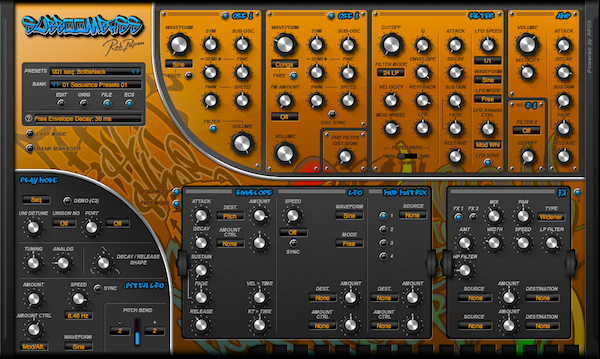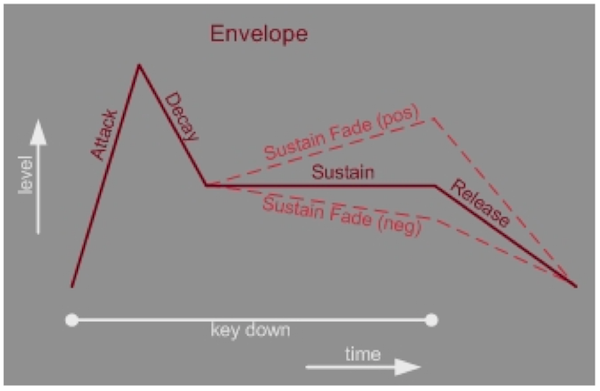Rob Papen’s SubBoomBass is a unique hybrid synthesizer aimed at giving you all of the tools you need to create powerful tracks that will test the lower limits of any sound system. Capable of everything from rich mid-range bass tonalities to all out sub-bass chaos, SubBoomBass is a versatile and unique plugin that delivers pristine sound quality and unparalleled rumbling ability. Here, we’ll explore some of the features of SubBoomBass and show you how to get the most out of this veritable bass cannon of a synth. To hear Rob Papen’s SubBoomBass in action check it out on our featured plugin page and explore projects on Splice below that use it:
Oscillator Modules
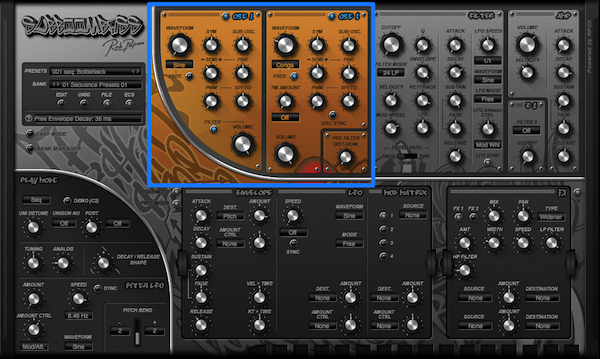
Rob Papen’s SubBoomBass features two oscillator modules that provide you with over 50 waveforms, including classics such as square and saw as well as more complex and unique waveforms such as conga and jungle. You can easily cycle through the available waveforms by adjusting the WAVEFORM knob at top left. Just to the right is the SYMETTRY knob, which allows you to adjust the position of the waveform and its pulse width. SubBoomBass also provides a SUB OSCILLATOR, which is a quick and easy way to add further low frequency content to your sound. To adjust the tuning of the oscillators, you can use the SEMI knob to transpose pitch by semitones or the FINE knob to transpose pitch by cents. Each oscillator also features a FREE switch that defines whether the selected waveform will return to its initial position each time a new note is played, or continue in an uninterrupted cycle.
Below these controls are the PWM and SPEED knobs. PWM stands for Pulse Width Modulation, which in this case alters the symmetry of the oscillator’s waveform over time as defined by the SPEED knob. Each oscillator module has a VOLUME knob that controls the amplitude of the signal before it passes to the filter module, so it’s easy to balance the output of each oscillator.
Specific to OSCILLATOR 1 is the FILTER switch, which provides you with the option of sending its output directly to OSCILLATOR 2 rather than to the filter module, which is useful when using it purely as a cross modulation source. To activate this functionality, turn OSCILLATOR 1‘s FILTER switch off and select either FM (frequency modulation) or RING modulation on OSCILLATOR 2 via its FM MODE menu. Then simply adjust the amount of modulation by using OSCILLATOR 2‘s FM AMOUNT knob. Specific to OSCILLATOR 2 is the OSCILLATOR SYNC switch, which synchronizes the frequency of OSCILLATOR 1 to that of OSCILLATOR 2, as well as a PRE-FILTER DISTORTION/VOWEL knob that adds saturation and upper harmonics to the signal prior to its introduction to the filter module.
Filter Module
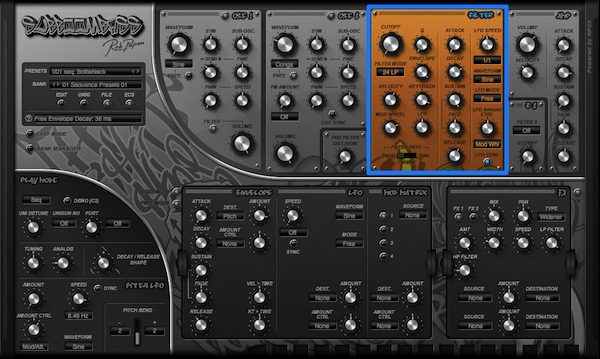
SubBoomBass features a unique filter module with 14 different filter types that are capable of subtly or drastically altering the character of your sound, especially when used in conjunction with the modulation matrix at the bottom of the unit. You can select the desired filter type by choosing one from the FILTER MODE selection menu. It’s in this section that you have a CUTOFF knob for determining the operating frequency of the selected filter, a Q knob to determine its bandwidth, and an ENVELOPE knob to coordinate the amount of integration with the filter’s internal envelope. SubBoomBass’ Filter, Amplifier, and Modulation modules all have identical ADSFR (attack decay sustain fade release) envelopes that allow you to control the way in which your sound’s characteristics change over time.
Nested below the main filter section are controls for adjusting the filter’s reaction to incoming MIDI information, which adds even more advanced filter functionality and a heightened level of expression and playability. SubBoomBass provides a VELOCITY knob, for adjusting the amount of impact that key velocity will have on filter action; a KEYTRACK knob, for adjusting the amount of impact that note information will have on filter action; a MOD WHEEL knob, for adjusting the amount of impact that the mod wheel will have on filter action; and an LFO knob, which determines the degree to which the filter module’s internal LFO (low frequency oscillator) will impact filter action. Rob Papen’s SubBoomBass also gives you several options for filter routing as defined by the PATH SELECTOR switch. You can choose to route the filters in SERIAL mode, PARALLEL mode, or SPLIT mode.
Amplifier Module

Immediately following the filter module is an amplifier module that allows you to tweak your sound’s amplitude envelope prior to the final output stage, as well as a secondary filter to roll-off any unwanted frequency content that may materialize as a result of combining the other modules. The amplifier envelope follows the same ADSFR protocol as the filter module and provides you with a VELOCITY control for determining the degree to which key velocity will have an impact on the operation of the amplitude envelope.
Play Mode and Pitch LFO
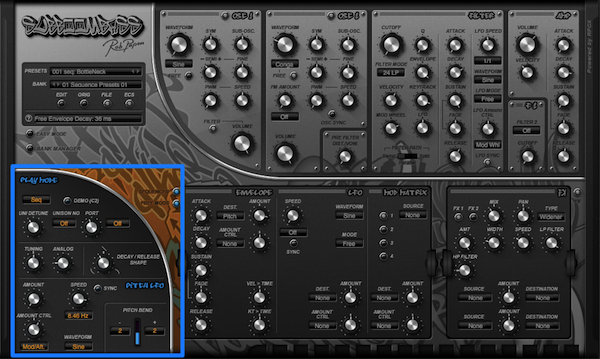
The PLAY MODE and PITCH LFO modules at bottom left provide you with more options for deciding how Rob Papen’s SubBoomBass should handle incoming MIDI information and how it should distribute that information to its internal unison and voicing algorithms. SubBoomBass provides four voicing options; two MONOPHONIC modes, two LEGATO modes, a SEQUENCER mode, and a POLYPHONIC mode, as well as a DEMO switch to audition your selected voicing settings. There are also eight UNISON modes available, each of which allows you to stack SubBoomBass’ voices in to various octave-based configuarations, as well as a PORTAMENTO control for defining the way in which SubBoomBass will handle overlapping notes. Below these controls are the TUNING knob, for adjusting the tuning of SubBoomBass globally; the ANALOG knob, for introducing random pitch drift as is commonly found in vintage hardware equipment; and the DECAY/RELEASE SHAPE adjustment knob, which allows you to control the amplitude shape of SubBoomBass’ decay envelope and release samples globally. The PITCH LFO module is a dedicated modulator that will allow you to achieve vibrato-like effects. It contains a SPEED knob which will set the rate of modulation either by hertz or steps as defined by the postition of the SYNC switch, as well as an AMOUNT knob which controls the depth of the pitch modulation and can easily be linked to any MIDI controller via the SOURCE menu. It’s also here that you have control over the range of SubBoomBass’ behavior relative to your controller’s pitch bend wheel via the PITCH BEND module.
Modulation and Sequencer

Rob Papen’s SubBoomBass contains a flexible and feature-rich MODULATION MATRIX that allows you to assign up to four sources to four targets simultaneously, each with an AMOUNT control and an AMOUNT CNTRL menu paired with an assignable knob. This converts any incoming MIDI information or controller action you choose in to a trigger source that determines the degree to which the modulator will have an effect on the signal. SubBoomBass also provides you with a FREE ENVELOPE and FREE LFO that can be used as trigger sources to modulate any modulation destination that you choose. This is a great way to create patches that are more fluid and have an abundance of evolving characteristics. Rob Papen’s SubBoomBass also includes a powerful SEQUENCER module that allows you to create 1-16 step sequences with adjustment controls for TIE, SLIDE, TUNE, VELOCITY, and FREE, which is useful for discovering creative phrases that add a sense of drive and momentum.
Effects Section
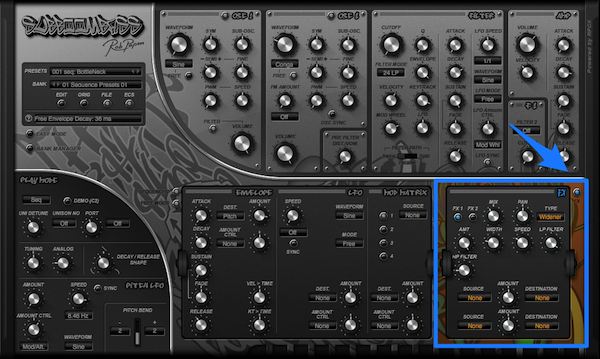
As if that weren’t enough, Rob Papen’s SubBoomBass throws in a comprehensive effects section to round everything out and to give your sound its finishing touches. Here you have a plethora of fully developed studio effects at your disposable, each with a multitude of effect-specific controls. SubBoomBass allows you to stack up to two effects simultaneously, with the available effects ranging from classics such as stereo delay and reverb to more complex and unique effects such as gator and enemble. SubBoomBass even provides you with two additional modulation slots in the effects section so that you can cross-modulate effect parameters just as easily as you would in the MODULATION MATRIX.
Rob Papen’s SubBoomBass is a popular plugin among Splice users because it delivers rich bass textures in a unique interface and gives you everything you need to give your tracks some serious low end.
You can download a demo of Rob Papen’s SubBoomBass or purchase it for $119 right here at their webstore. As always, be sure to check out some of our featured Splice projects below to get a better sense of what Rob Papen’s SubBoomBass can add to your productions!
September 18, 2014

.svg)
.svg)

